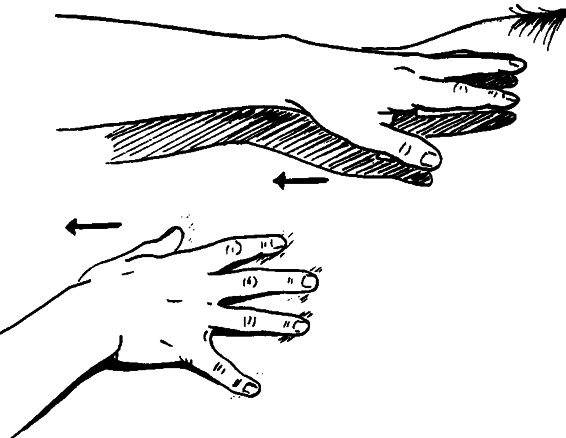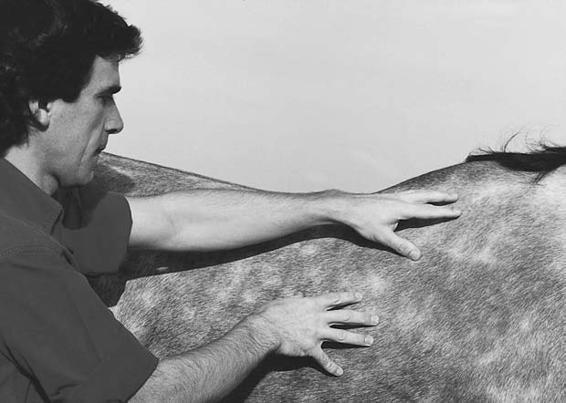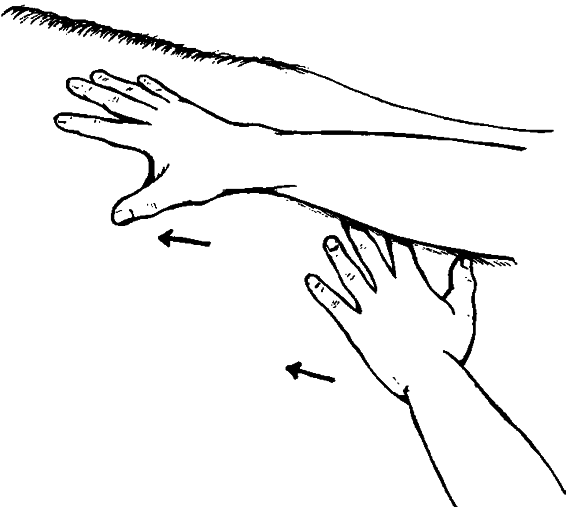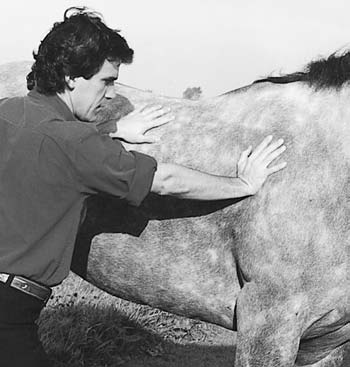Equine Massage: A Practical Guide (14 page)
Read Equine Massage: A Practical Guide Online
Authors: Jean-Pierre Hourdebaigt

The Main Effects of Massage
The Mechanical Effect
The mechanical effect is the actual physical contact caused by pressure on the body. Therefore the mechanical effect is directly proportional to pressure. The force you exert in the massage movements will stretch the tissues and drive the fluids (arterial, venous, and lymphatic) in the direction of the movements. Light pressure will gently start things moving, whereas heavier pressure will affect more efficiently the circulation of fluid in the area being worked on.The positive effects of increased fluid circulation are:
❖ Better tissue oxygenation
❖ Good metabolism
❖ Removal of carbon dioxide
❖ Lowered blood pressure
Deep mechanical pressure will also contribute to the release of endorphins.
Endorphins
are secreted in the brain and help the body diminish the awareness of pain. Although unproven by scientific research, it is thought that massage inhibits pain by stimulating the release of endorphins.
The mechanical pressure of specific massage moves will stretch and soften the tissues. This stretching and softening will help release muscle tension, contractures, trigger points, stress points, and spasms, eventually breaking down collagen fibers (scar tissue).
Note:
On a human, mechanical pressure on the abdomen will affect the digestive organs and stimulate digestion. But on a horse,
60
Equine Massage
you should be very cautious when working on this area; it’s very sensitive and the horse is very protective. Be aware!
Mechanical pressure also produces an effect on the nervous system. Depending on the type of application, it will either stimulate or soothe muscles. For example, slow, rhythmic, light-to-medium pressure will soothe and relax very efficiently, whereas faster rhythm with medium-to-heavy pressure will stimulate very quickly.
Pure Nervous Reflex Effect
The pure nervous reflex effect, as the name suggests, influences only the nervous system. This effect is achieved with a very light touch. Exert almost no pressure; rather, contact the skin lightly to touch the cutaneous sensory nerve endings.
Stroking, light effleurage, and wide and very gentle kneadings are mostly used to elicit this effect. Gentle stimulation of the skin sends relaxing impulses to the brain. The motor nerves then “let go” of the tension. For this type of massage, use a slow, gentle, soothing and nourishing rhythm of 1 stroke per second on average.
Pure nervous reflex does not increase the secretion of glands, cause a chemical response, or have a mechanical impact on circulation of fluids, but it will soothe and relax a horse that is in a state of general tension, anxiety, shock, or pain. (See the relaxation massage routine in chapter 6.)
Massage Moves
There are eight essential classes of massage moves (stroking, effleurage, petrissage, shaking, vibration, friction, nerve manipulation, and tapotements), and a multitude of combinations.
Each individual class has several moves and each move can be performed in either a soothing or stimulating manner, depending upon pressure and rhythm. Some of the movements appear very similar, but they all offer specifics you need to be aware of. This knowledge will help you become expert in choosing the right massage moves.With practice these movements will become second nature to you.
Stroking
Stroking is used for its soothing, relaxing, calming effect (pure nervous reflex effect) on the body, directly affecting the central nervous system. It is the main move used in the relaxation massage routine. When the horse is very nervous, stroking his back and legs will soothe and “ground” him.


Principles and Concepts of Massage
61
3.4 Stroking Movement
3.5 Stroking Massage Movement
You always start or finish a massage routine or massage treatment by applying several strokings over the body part that has been worked on. Also use strokings to weave together various massage techniques or when moving from one area of the body to another.
Stroking movements are performed in a relaxed, superficial manner with the tips of the fingers or the palms of the hands. When stroking, use very light pressure, from 0.1 to 1 pound of pressure—
2 pounds maximum when working on a heavy coat. Stroking can


62
Equine Massage
3.6 Effleurage Movement
3.7 Effleurage Massage Movement
be done in any direction, but preferably along the length of the muscles, or following the direction in which the hair lies.
Done in slow motion, stroking gives a very soothing, relaxing sensation, producing an almost sedative effect. Done fast, stroking will have a stimulating, almost exciting, effect on the animal’s nervous system.
Effleurage
Effleurage is the move you will use the most. Effleurage is used as every second move (every 20 to 30 seconds) during any massage work to emphasize proper drainage. It is also used after strokings

Principles and Concepts of Massage
63
to start or weave between movements during any massage routine or technique.To assist the natural flow of the venous blood circulation, always perform effleurage toward the heart.
Effleurage is a gliding movement done with the fingers and palm. During a one-handed effleurage stroke, the thumb never leads the hand but rather follows the fingers.The hand should be well-molded and in full contact with the body part being massaged. You can use one or both hands, simultaneously or alternately, in an even, gliding movement.The pressure is usually even throughout the entire stroke, except when going over bony processes such as the scapular ridge, point of the hip, point of elbow, or hock.
Effleurage has a mechanical, draining effect on body fluids such as blood and lymph. This draining effect is proportional to the pressure applied and the rhythm of the movement.
When performed in a superficial manner with a light pressure (2 or 3 pounds) and a slow rhythm (an average of 1 stroke per second, 2 seconds for long strokes over big muscles), effleurage will have a very soothing effect and boost circulation as well.This massage move is a very good one to start or finish a massage. When effleurage is done with a faster rhythm (2 to 3 strokes per second), it is more stimulating. It can be used in this way during treatment on small areas to drain swelling without hurting the structure. But do not use this combination over a large area. The fast rhythm often causes nerve irritation and makes the horse nervous.
When effleurage is applied in a deep manner with heavy pressure (10 or 15 pounds) and in a slow rhythm, it stimulates the circulation of blood and lymph.Yet the slow
rhythm still soothes the nervous
system.This combination is used
to drain large areas between
sequences of massage moves after
heavy training. (See the maintenance massage routine and recuperation routine in chapter 6.)
When doing effleurage on a
narrow area (the lower legs, for
example), use mostly the palmar region of the fingers
instead of the whole hand.
Adjust the pressure according
to the structure being worked
on. Work lightly over thin
muscle layers and bony structures but more heavily over
3.8 Petrissage: Kneading
thick muscle groups.
Movement

64
Equine Massage
3.9 Double Thumb Kneading Movement
Petrissage
Petrissage is the foundation movement of massage. It comprises kneading, compression, muscle squeezing, picking up, wringing up, and skin rolling. All these moves are mechanical and soothing, but if done quickly they will become stimulating. Petrissage manipulations alternate pressure and relaxation.
In the kneading, compression, and muscle squeezing massage moves, the tissues are pressed against the underlying structure. In the wringing-up, picking-up, and skin-rolling massage moves, the tissues are lifted away from the underlying structure. Used constantly in sport massage, these moves work on muscle tension, muscle knots, congestion, and small spasms.
